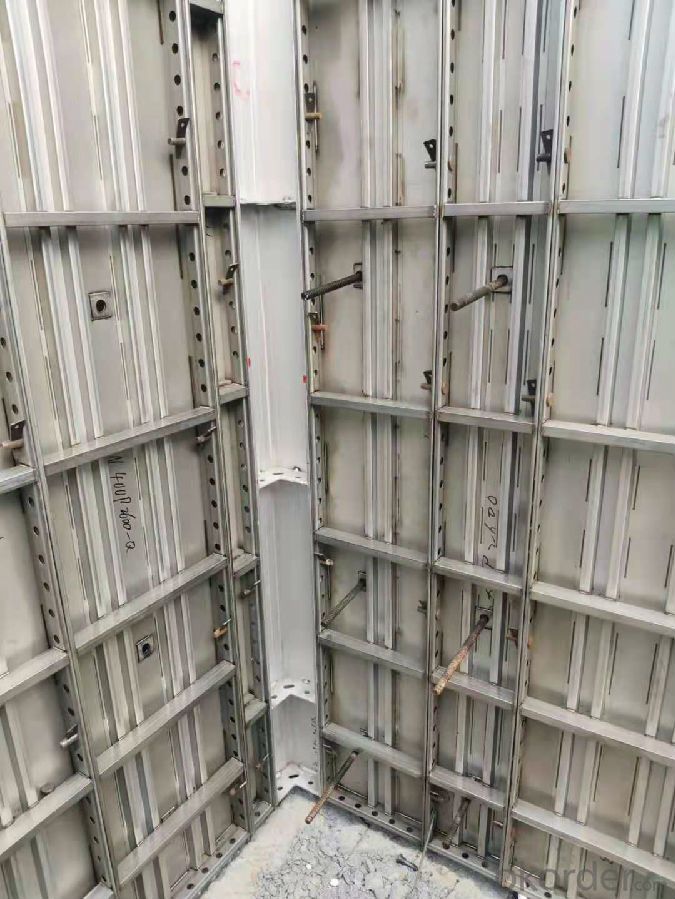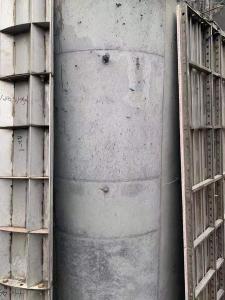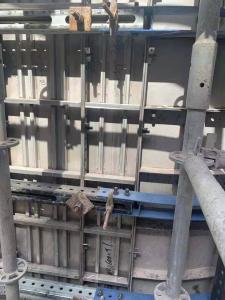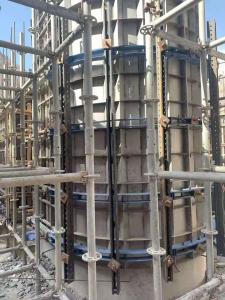High quality column steel formwork,metal formwork, Stainless Steel Formwork
- Loading Port:
- Shanghai
- Payment Terms:
- TT or LC
- Min Order Qty:
- 1 set
- Supply Capability:
- 1000000 set/month
OKorder Service Pledge
OKorder Financial Service
You Might Also Like
Stainless steel formwork
Replaceable size aluminum formwork :400X1200mm , 400X1500mm
PRODUCT SPECIFICATIONS
Panel thickness 120mm
Extremely strong and rigid
Fully compatible with Tricon system
Large size panels
Limited number of parts
High pressure resistance, minimum 100kn/m2
Long life expectancy
Stainless although magnetic sheets
Advantages:
1 Stainless steel formwork, 100% follow the design of aluminum alloy formwork system, it is interchangeable, compatible and can be used together with aluminum formwork at the same time .
2 (The maintenance of the floor or wall is simple and convenient, clean and smooth, easy to remove the mold, and the surface is beautiful.)
Integrated with the thermal insulation structure, the construction will be finished is fast, the efficiency is improved, no release agent is required, the wall has good flatness after de-moulding, no leveling is required, labor cost and time are saved . The construction speed of 5-6 floors a month shortens the construction period and saves Various expenses of the construction general contractor
3Long service life, many turnover times, high recycling value
The number of turnovers is large, especially the characteristics of no dust, no need to brush or less mold release agent, and the characteristics of low renovation costs will bring unlimited optimistic prospects to it.



- Q:Can steel formwork be used in areas with high wind loads?
- Areas with high wind loads can utilize steel formwork. Steel formwork is renowned for its strength, durability, and stability, making it an ideal choice for construction projects in such areas. The robustness and rigidity of steel formwork enable it to withstand the immense force and pressure exerted by strong winds, ensuring the safety and stability of the structure under construction. Moreover, compared to other formwork materials, steel formwork offers a superior level of resistance to deformation and movement, rendering it more dependable in areas prone to high wind loads. Nonetheless, it is imperative to properly secure and anchor the steel formwork to the ground to further enhance its resistance against wind loads.
- Q:How does steel formwork affect the overall sustainability of a concrete structure?
- The overall sustainability of a concrete structure can be significantly influenced by steel formwork. To begin with, the reusability of steel formwork allows for its utilization in multiple construction projects, thereby reducing the need for additional materials and minimizing waste. This reusability also aids in decreasing the environmental impact associated with the production and disposal of formwork materials. Furthermore, the durability and robustness of steel formwork ensure that it can endure repeated use without compromising its structural integrity. This durability extends the lifespan of the formwork, resulting in fewer replacements and less waste generation. Additionally, steel formwork provides superior strength and stability, enabling the construction of concrete structures with greater precision and efficiency. This allows for the use of less concrete, thereby reducing the overall carbon footprint of the structure. Moreover, the utilization of steel formwork can lead to quicker construction times, which in turn reduces energy consumption and minimizes the project's environmental impact. Moreover, steel formwork allows for greater flexibility in design and construction techniques, thus enabling the development of more sustainable structures. It can be easily customized to fit various shapes and sizes, optimizing space usage and reducing material wastage. This flexibility also allows for the incorporation of sustainable features such as energy-efficient insulation, green roofs, or rainwater harvesting systems. In conclusion, steel formwork positively influences the overall sustainability of a concrete structure through its reusability, durability, strength, and flexibility. By reducing waste generation, minimizing the use of concrete, and enabling sustainable design options, steel formwork contributes to the creation of more environmentally-friendly and efficient structures.
- Q:Can steel formwork be used in areas with limited labor availability?
- Yes, steel formwork can be used in areas with limited labor availability. Steel formwork is known for its durability and reusability, making it suitable for areas where labor is scarce. It requires minimal manual labor for assembly and disassembly, reducing the need for a large workforce. Additionally, steel formwork systems are designed to be easily transported and installed, allowing for efficient construction processes even in areas with limited labor resources.
- Q:How does steel formwork affect the overall architectural aesthetics of the structure?
- The overall architectural aesthetics of a structure can be significantly impacted by steel formwork. When steel is used as a material for formwork, it can give the building a sleek and modern appearance. Its smooth and rigid surface allows for precise and clean lines, resulting in a more refined and elegant look. Steel formwork also provides great flexibility in terms of design possibilities. It can be easily shaped and molded into complex and intricate patterns, allowing architects to create unique and visually appealing structures. This versatility opens up a wide range of architectural possibilities and enables the creation of buildings with distinct and eye-catching features. Furthermore, steel formwork offers a high level of structural stability, which enhances the overall aesthetics of the structure. The use of steel ensures that the formwork remains strong and sturdy, even under heavy loads. This is crucial for creating large and imposing architectural designs. The ability to use steel formwork in such constructions allows architects to achieve bold and impressive architectural forms that might not be possible with other materials. In addition to its visual impact, steel formwork also offers practical advantages. It is a durable and long-lasting material that can withstand harsh weather conditions, making it suitable for both indoor and outdoor applications. Steel formwork is also highly resistant to fire, corrosion, and pests, further ensuring the longevity and integrity of the structure. Overall, steel formwork plays a crucial role in shaping the architectural aesthetics of a structure. Its smooth surface, flexibility in design, structural stability, and durability contribute to creating visually appealing and iconic buildings. By choosing steel formwork, architects can achieve both functional and aesthetic goals, resulting in structures that are not only beautiful but also reliable and long-lasting.
- Q:Types of building templates? What is the clear water template
- 3: bamboo plywood is the earliest use of plain bamboo plywood template, has developed a bamboo bamboo plywood coated template, bamboo plywood, wood coating or coating bamboo plywood etc.. Commonly used in Shandong, Guangxi.4 wood plywood (water templates): currently widely used in the solid wood plywood formwork, should promote the use of wood covered plywood. Commonly used in Guangdong area of Eucalyptus wood membrane.
- Q:Are there any safety precautions to consider when using steel formwork?
- Yes, there are several safety precautions to consider when using steel formwork. Firstly, proper training should be provided to all workers involved in the assembly, dismantling, and use of steel formwork. Workers should be aware of the potential hazards, such as falling objects, and should use appropriate personal protective equipment (PPE) such as hard hats and safety harnesses. Additionally, regular inspections of the formwork should be conducted to ensure its structural integrity and stability. Adequate bracing and shoring should be in place to prevent collapse or movement of the formwork during concrete pouring. It is also important to follow manufacturer's guidelines and recommendations for the safe use of steel formwork. Overall, prioritizing safety measures and adhering to industry standards is crucial to minimize the risk of accidents or injuries when using steel formwork.
- Q:What are the typical deflection limits for steel formwork systems?
- The typical deflection limits for steel formwork systems vary depending on the specific project requirements and design specifications. However, a common industry standard is to limit the deflection of steel formwork systems to be within 1/360th of the span length. This ensures structural integrity and minimizes any potential issues during the construction process.
- Q:What are the different types of steel formwork?
- There are several types of steel formwork used in construction projects, including traditional steel formwork, modular steel formwork, and tunnel formwork. Traditional steel formwork involves the use of customized steel panels that are assembled on-site to create the desired formwork shape. Modular steel formwork consists of pre-made steel panels that can be easily fitted together to form various shapes and sizes. Tunnel formwork, on the other hand, is a specialized type of steel formwork used in tunnel construction, where large steel sections are assembled to create a continuous tunnel structure.
- Q:Can steel formwork be used for architectural concrete finishes?
- Yes, steel formwork can be used for architectural concrete finishes. Steel formwork offers a number of advantages that make it suitable for creating high-quality architectural finishes. Firstly, steel formwork provides excellent dimensional accuracy and stability, ensuring that the concrete is poured and cured in the desired shape and size. This allows for precise and intricate architectural detailing. Furthermore, steel formwork is highly durable and can withstand the pressure and weight of the concrete during the pouring and curing process. This durability ensures that the formwork remains intact and does not deform or warp, resulting in a smooth and even concrete finish. Steel formwork also allows for easy demolding, as it can be easily dismantled without damaging the concrete structure. This makes it convenient for achieving architectural finishes that require complex shapes or multiple components. In addition, steel formwork can be easily reused, making it a cost-effective option for architectural projects. It can withstand multiple uses, reducing the need for frequent replacements and saving both time and money. However, it is important to note that the choice of formwork material depends on the specific requirements of the architectural concrete finish. While steel formwork is suitable for most applications, there may be instances where other materials such as wood or plastic formwork are more appropriate. Consulting with a structural engineer or a construction professional can help determine the most suitable formwork material for a particular architectural concrete finish.
- Q:How does steel formwork handle different concrete strength requirements?
- Steel formwork is a versatile and robust solution that can effectively handle different concrete strength requirements. The strength of concrete is determined by its mixture proportions, curing conditions, and the quality of materials used. Steel formwork plays a crucial role in ensuring that these requirements are met by providing a reliable and secure framework for the concrete to be poured into. One of the key advantages of steel formwork is its ability to withstand high pressures and strong vibrations caused during the pouring and compaction of concrete. This is particularly important when dealing with high-strength concrete, which requires greater force to be applied to achieve the desired density and durability. Steel formwork's structural integrity and rigidity allow it to bear these forces without deformation or failure, ensuring a uniform and consistent distribution of the concrete. Steel formwork also offers flexibility in terms of shape and size, allowing it to be customized according to different concrete strength requirements. This allows for the construction of various structural elements, such as columns, beams, walls, and slabs, which may have different strength specifications. Steel formwork can be easily assembled and disassembled, making it adaptable to different projects and enabling the reuse of formwork components. Furthermore, steel formwork provides a smooth and precise finish to the concrete surface, which is essential for achieving the desired aesthetics and functionality. This is particularly important when dealing with architectural or decorative concrete that requires a high-quality finish. The smooth and flat surface provided by steel formwork ensures that the concrete cures evenly and minimizes the risk of surface defects. In summary, steel formwork is well-equipped to handle different concrete strength requirements due to its strength, durability, adaptability, and ability to provide a smooth finish. Its robustness and flexibility make it an ideal choice for construction projects that require varying concrete strengths, ensuring the successful execution of diverse structural designs and meeting the desired performance requirements.
1. Manufacturer Overview |
|
|---|---|
| Location | |
| Year Established | |
| Annual Output Value | |
| Main Markets | |
| Company Certifications | |
2. Manufacturer Certificates |
|
|---|---|
| a) Certification Name | |
| Range | |
| Reference | |
| Validity Period | |
3. Manufacturer Capability |
|
|---|---|
| a)Trade Capacity | |
| Nearest Port | |
| Export Percentage | |
| No.of Employees in Trade Department | |
| Language Spoken: | |
| b)Factory Information | |
| Factory Size: | |
| No. of Production Lines | |
| Contract Manufacturing | |
| Product Price Range | |
Send your message to us
High quality column steel formwork,metal formwork, Stainless Steel Formwork
- Loading Port:
- Shanghai
- Payment Terms:
- TT or LC
- Min Order Qty:
- 1 set
- Supply Capability:
- 1000000 set/month
OKorder Service Pledge
OKorder Financial Service
Similar products
New products
Hot products
Related keywords


























